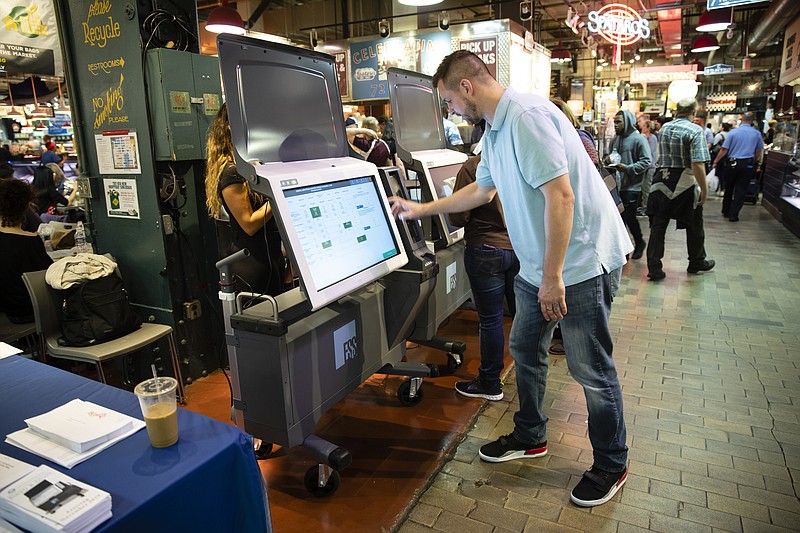In the rush to replace insecure, unreliable electronic voting machines after Russia's interference in the 2016 U.S. presidential race, state and local officials have scrambled to acquire more trustworthy equipment for this year's election, when U.S. intelligence agencies fear even worse problems.
However, instead of choosing simple, hand-marked paper ballots that are most resistant to tampering because paper cannot be hacked, many are opting for pricier technology computer security experts consider almost as risky as earlier discredited electronic systems.
Called ballot-marking devices, the machines have touchscreens for registering voter choice. Unlike touchscreen-only machines, they print out paper records that are scanned by optical readers. South Carolina voters will use them in Saturday's primary.
The most pricey solution available, they are at least twice as expensive as the hand-marked paper ballot option. They have been vigorously promoted by the three voting equipment vendors that control 88 percent of the U.S. market.
Some of the most popular ballot-marking machines, made by industry leaders Election Systems & Software and Dominion Voting Systems, register votes in bar codes that the human eye cannot decipher. That's a problem, researchers said: Voters could end up with printouts that accurately spell out the names of the candidates they picked, but, because of a hack, the bar codes do not reflect those choices. Because the bar codes are what's tabulated, voters would never know that their ballots benefited another candidate.
Even on machines that do not use bar codes, voters may not notice if a hack or programming error mangled their choices. A University of Michigan study determined only 7 percent of participants in a mock election notified poll workers when the names on their printed receipts did not match the candidates they voted for.
ES&S rejects those scenarios. Spokeswoman Katina Granger said the company's ballot-marking machines' accuracy and security "have been proven through thousands of hours of testing and tens of thousands of successful elections." Dominion declined to comment for this story.
Nearly one in five U.S. voters will be using ballot-marking machines this year, compared with less than 2 percent in 2018, according to Verified Voting, which tracks voting technology.
Pivotal counties in the crucial states of Pennsylvania, Ohio and North Carolina have bought ballot-marking machines. So have counties in much of Texas, as well as California's Los Angeles County and all of Georgia, Delaware and South Carolina. The machines' certification has often been streamlined in the rush to get machines in place for presidential primaries.
Ballot-marking devices were not conceived as primary vote-casting tools but as accessible options for people with disabilities.
Critics see them as vulnerable to hacking. At last year's DefCon hacker convention in Las Vegas, it took tinkerers at the 'Voting Village' not even eight hours to hack two older ballot-marking devices.
Tampering aside, some of the newer ballot-marking machines have stumbled badly in actual votes. That happened most spectacularly in November when ES&S's top-of-the-line ExpressVote XL debuted in a Pennsylvania county.
Even without technical troubles, the new machines can lead to longer lines, potentially reducing turnout. Voters need more time to cast ballots and the machine's high costs have prompted election officials to limit how many they purchase.
"There are a huge number of reasons to reject today's ballot-marking devices - except for limited use as assistive devices for those unable to mark a paper ballot themselves," said Doug Jones, a University of Iowa computer scientist who co-authored the voting technology history "Broken Ballots."'
However, election officials see ballot-marking devices as improvements over paperless touchscreens, which were used by 27 percent of voters in 2018. They like them because the touchscreens are familiar to voters, looking and feeling like what they have been using for nearly two decades, and officials can use one voting method for everyone.
Michael Anderson, elections director for Pennsylvania's Lebanon County, said "voters want it." The county offers voters machine- and hand-marked ballots.
"When we give them a paper ballot, the very first thing they say to us is, 'We're going back in time,'" he said.
New York State election commission co-chair Douglas Kellner was an early critic of paperless electronic voting machines. However, he is confident in a ballot-marking device, the ImageCast Evolution by Dominion, certified for use in his state. He said safeguards built into the machines and security protocols make a hack of the Image Evolution "extraordinarily unlikely."
However, Jones is among experts who think today's ballot-marking devices undermine the very idea of retaining a paper record that can be used in audits and recounts. It's an idea supported by a 2018 National Academies of Sciences report favors hand-marked paper ballots tallied by optical scanners. Some 70 percent of U.S. voters used them in the past two presidential elections and will do so again in November.

